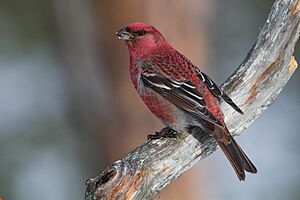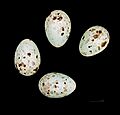Pine grosbeak facts for kids
Quick facts for kids Pine grosbeak |
|
|---|---|
 |
|
| Male | |
 |
|
| Female in Canada | |
| Conservation status | |
| Scientific classification | |
| Genus: |
Pinicola
|
| Species: |
enucleator
|
 |
|
| Breeding range of P. enucleator Resident Non-breeding | |
| Synonyms | |
|
Loxia enucleator Linnaeus, 1758 |
|
The pine grosbeak is a beautiful bird that belongs to the finch family. It's quite a large finch and is the only bird in its group called Pinicola. You can find these birds living in conifer forests across many cold regions. They live in places like Alaska, the mountains of the western United States, Canada, and also in northern Europe (like Fennoscandia) and across Asia (called the Palearctic) all the way to Siberia.
Pine grosbeaks love to eat fruit, especially in winter. They enjoy small fruits like those from rowan trees. Sometimes, there aren't enough fruits in their usual homes. When this happens, pine grosbeaks might travel long distances to find food. This special kind of movement is called an irruption. During these years, you might see them much farther south than usual.
Contents
Understanding Pine Grosbeak Names
Scientists give every living thing a special two-part name, like a first and last name. This helps everyone around the world know exactly which plant or animal they are talking about. This system is called binomial nomenclature.
The pine grosbeak was first officially described in 1758 by a Swedish scientist named Carl Linnaeus. He gave it the name Loxia enucleator. Later, in 1808, a French bird expert named Louis Pierre Vieillot created a new group, or genus, just for this bird, calling it Pinicola. Now, the pine grosbeak is the only species in the Pinicola genus.
The name Pinicola comes from Latin words. Pinus means "pine tree," and colere means "to dwell." So, Pinicola means "pine dweller." The second part of its name, enucleator, also comes from Latin and means "to remove the kernel." This might refer to how the bird eats seeds.
Different Types of Pine Grosbeaks
Just like people can come from different places and have slightly different looks or accents, animals can have subspecies. These are groups within a species that are a bit different, often because they live in different areas. There are eight recognized subspecies of the pine grosbeak:
- P. e. enucleator: Found from Scandinavia to central Siberia.
- P. e. kamtschatkensis: Lives in northeastern Siberia.
- P. e. sakhalinensis: Found on Sakhalin and the Kuril Islands, and northern Japan.
- P. e. flammula: Lives along the coast of southern Alaska and western Canada.
- P. e. carlottae: Found on the Queen Charlotte Islands off western Canada.
- P. e. montana: Lives inland from southwestern Canada to the west-central U.S.
- P. e. californica: Found in eastern California.
- P. e. leucura: Lives inland from west-central Alaska to eastern Canada and northern New England in the U.S.
What Does a Pine Grosbeak Look Like?
The pine grosbeak is one of the biggest birds in the finch family. It is about 20 to 25.5 centimeters (8 to 10 inches) long. It usually weighs between 52 and 78 grams (about 1.8 to 2.7 ounces). Its wingspan is about 33 centimeters (13 inches).
Adult pine grosbeaks have a long, forked black tail and black wings with white bars. They also have a large, strong beak.
- Males: Adult males are easy to spot! They have a beautiful rose-red head, back, and rump.
- Females: Adult females are olive-yellow on their head and rump, and grey on their back and belly.
- Young Birds: Young pine grosbeaks have less bright colors. They might look a bit shaggy when they are changing their feathers.
Pine Grosbeak Sounds
The sounds pine grosbeaks make can be a little different depending on where they live. Their calls often sound like a whistled pui pui pui or chii-vli. Their song is a short, musical warble.
Where Pine Grosbeaks Live and Travel

Pine grosbeaks make their nests in the boreal forests of northern Europe, Asia, and North America. Most of the time, they stay in these areas all year round. Sometimes, they might fly short distances to the southern edges of these forests for winter.
However, during those "irruption" years we talked about, more birds will travel farther south. In North America, this means they might go well beyond their usual winter homes, reaching places like the northern Great Lakes region and northern New England in the United States. They are very rare visitors to warmer parts of Europe. These birds prefer to live in conifer forests and other types of woodlands.
Pine Grosbeak Behavior and Life Cycle
Pine grosbeaks build their nests on a horizontal branch or in a fork of a conifer tree. These birds usually stay in the same area for most of their lives. But if food is hard to find, especially in the far north, they might migrate farther south to find food.
When it's time to have babies, both male and female pine grosbeaks develop special pouches in their throats. These are called gular pouches. They use these pouches to store seeds, which they then feed to their young.
Pine grosbeaks look for food in trees and bushes. They mainly eat seeds, buds, berries, and insects. When it's not nesting season, they often feed together in flocks.
-
Front view of female, notice forked tail, Gatineau Park, Quebec





